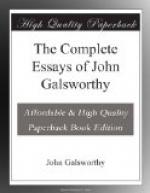To me, then—I thought—this division into Realism and Romance, so understood, is the main cleavage in all the Arts; but it is hard to find pure examples of either kind. For even the most determined realist has more than a streak in him of the romanticist, and the most resolute romanticist finds it impossible at times to be quite unreal. Guido Reni, Watteau, Leighton were they not perhaps somewhat pure romanticists; Rembrandt, Hogarth, Manet mainly realists; Botticelli, Titian, Raphael, a blend. Dumas pere, and Scott, surely romantic; Flaubert and Tolstoy as surely realists; Dickens and Cervantes, blended. Keats and Swinburne romantic; Browning and Whitman—realistic; Shakespeare and Goethe, both. The Greek dramatists—realists. The Arabian Nights and Malory romantic. The Iliad, the Odyssey, and the Old Testament, both realism and romance. And if in the vagueness of my thoughts I were to seek for illustration less general and vague to show the essence of this temperamental cleavage in all Art, I would take the two novelists Turgenev and Stevenson. For Turgenev expressed himself in stories that must be called romances, and Stevenson employed almost always a naturalistic technique. Yet no one would ever call Turgenev a romanticist, or Stevenson a realist. The spirit of the first brooded over life, found in it a perpetual voyage of spiritual adventure, was set on discovering and making clear to himself and all, the varying traits and emotions of human character—the varying moods of Nature; and though he couched all this discovery in caskets of engaging story, it was always clear as day what mood it was that drove him to dip pen in ink. The spirit of the second, I think, almost dreaded to discover; he felt life, I believe, too keenly to want to probe into it; he spun his gossamer to lure himself and all away from life. That was his driving mood; but the craftsman in him, longing to be clear and poignant, made him more natural, more actual than most realists.




